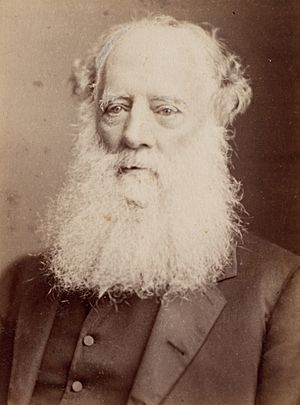William Branwhite Clarke facts for kids
Quick facts for kids
William Branwhite Clarke
|
|
|---|---|

Portrait of William Branwhite Clark, c. 1875, by J Hubert Newman
|
|
| Born | 2 June 1798 England
|
| Died | 16 June 1878 (aged 80) |
| Burial place | St Thomas Rest Park |
| Occupation | geologist |
William Branwhite Clarke (born June 2, 1798 – died June 16, 1878) was an important English geologist and clergyman. He later moved to Australia and became known as the "Father of Australian Geology." He made many discoveries about rocks, minerals, and fossils in Australia.
Contents
Early Life and Studies in England
William Clarke was born in East Bergholt, England. He was the oldest child of William Clarke, a schoolmaster. He studied at his father's house and at Dedham Grammar School.
In 1817, he went to Jesus College at Cambridge University. He wrote a poem called Pompeii in 1819. It was judged second best in a competition. He earned his first university degree in 1821 and a master's degree in 1824.
William became a clergyman in 1821. He worked in different churches until 1839. He also taught at the Free School of East Bergholt for about 18 months.
He became very interested in geology through his teacher, Adam Sedgwick. William gathered many facts about the geology of East Anglia. He wrote about his findings in a paper called On the Geological Structure and Phenomena of Suffolk in 1837.
Discoveries and Career in Australia
In 1839, William Clarke moved from England to New South Wales, Australia. He hoped the sea voyage would help him recover from an illness. He was also asked by English scientists to study the coal deposits in New South Wales.
William decided to stay in Australia. He became known as the "Father of Australian Geology" because of his important work. From 1839 to 1840, he was the headmaster of The King's School in Parramatta.
He continued his work as a clergyman until 1870. He served in parishes from Parramatta to the Hawkesbury River. He also worked in Campbelltown and Willoughby.
William was very dedicated to studying Australia's geology. His discoveries were very important for the country.
Finding Gold in Australia
In 1841, William found samples of gold in Australia. He found it in both loose dirt and in quartz rocks. This was in the area west of the Blue Mountains. He believed there was a lot of gold there.
Other people had found gold in Australia before William. These included James McBrien, Mr. R Lowe, and Lieutenant William Lawson. However, William was one of the first to find gold embedded in quartz rocks.
In 1844, he showed some gold samples to the governor, Sir George Gipps. Sir George told him to keep the discovery a secret. William agreed, thinking it might not be wise to announce gold in the colony. He knew about the gold since 1841.
William continued his church duties. But sometimes the government asked him to do geological research.
Other Important Discoveries
William Clarke made many other important discoveries:
- In 1849, he found the first tin in Australia.
- In 1859, he announced the discovery of diamonds.
- In 1860, he found Cretaceous fossils in Queensland.
- He was the first to identify Silurian rocks in Australia.
- He also figured out the age of the coal-bearing rocks in New South Wales.
- In 1869, he announced finding remains of Dinornis (a large extinct bird) in Queensland.
William finished the fourth edition of his book, Remarks on the Sedimentary Formations of New South Wales, on his 80th birthday. He passed away two weeks later on June 16, 1878. He was buried in the St Thomas cemetery. This was the graveyard of the church where he was rector for many years.
-
Queensland lungfish
(Neoceratodus forsteri).
William Clarke's Lasting Legacy
William Clarke was a trustee of the Australian Museum in Sydney. He was also an active member of the Royal Society of New South Wales. He served as its vice-president from 1866 to 1878. The Clarke Medal, an award given by the Society, is named in his honor.
In 1860, he published a book called Researches in the Southern Gold Fields of New South Wales. In 1876, he became a Fellow of the Royal Society in England. The next year, he received the Murchison Medal from the Geological Society of London. He wrote many articles for Australian science journals.
His name is remembered in several places today:
- William Clarke College, a school in Kellyville, New South Wales.
- The WB Clarke Geoscience Centre in Londonderry, New South Wales. This center is run by the Geological Survey of New South Wales.
William's work in geology included studying palaeontology, which is the study of fossils. He collected many fossils throughout his life. These collections helped start research on Australia's extinct plants and animals. He sent his fossil specimens to societies in England for scientific study. He kept up with new discoveries in geology and palaeontology, even from far away Australia.
See also
- Australian gold rushes
- William Clarke College




